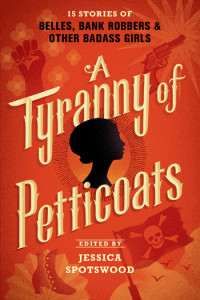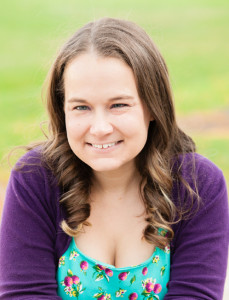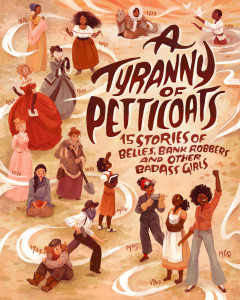 Young adult historical fiction has experienced a much awaited (at least for this author of historical fiction with international settings) renaissance in the past year or two. Many of the heralded titles focus on the feats of girls and young women and are written by authors with roots in the time, place, and cultures depicted. Jessica Spotswood’s new anthology, A Tyranny of Petticoats, offers 15 stories set at various moments in the history of the United States, beginning in 1710, when the country was still a colony of Great Britain, and ending with the unrest at the 1968 Democratic Convention. I had the opportunity to correspond with Spotswood about this anthology and its forthcoming companion, which will also focus on the stories of women and girls in U.S. history.
Young adult historical fiction has experienced a much awaited (at least for this author of historical fiction with international settings) renaissance in the past year or two. Many of the heralded titles focus on the feats of girls and young women and are written by authors with roots in the time, place, and cultures depicted. Jessica Spotswood’s new anthology, A Tyranny of Petticoats, offers 15 stories set at various moments in the history of the United States, beginning in 1710, when the country was still a colony of Great Britain, and ending with the unrest at the 1968 Democratic Convention. I had the opportunity to correspond with Spotswood about this anthology and its forthcoming companion, which will also focus on the stories of women and girls in U.S. history.
Why did you choose to edit an anthology of stories set in the past? What can historical fiction offer teen readers?
When I thought of editing an anthology, I knew right away I wanted it to be about clever, interesting, diverse American girls throughout history. I grew up outside Gettysburg, the site of an important Civil War battle; history was something ever-present and tactile for me. My dad was a history buff, but all of his books were about presidents and generals and statesmen. It highlighted for me how often the contributions of women – especially women of color and queer women – have been erased. I suppose I wanted – to borrow from Hamilton – to put women back in the narrative. I think it’s important that girls grow up seeing themselves reflected in all kinds of stories, including historical ones. After all, history is chock-full of good stories, with powerful heroines and rich conflicts and fascinating settings.
Many of the stories you include cross over into fantasy. How does historical fantasy contribute to our understanding of history?
I think, historically as now, many of us turn to stories – and often stories with fantastical elements – to make sense of our lives. We use folklore to give us comfort and closure in tragedy, as with Marie’s orphaned Inuit heroine or Jillian’s ill-fated sailor. Using fantasy, we can explore difficult themes, like the power dynamics of owning or controlling another person, at a bit of a remove, as with Andrea’s paranormal poker game. We can reclaim power for those who have little of it because of their race or gender or circumstance (Leslye’s Tejana sisters reimagined as the Three Fates or Marissa’s Chinese American medium finding justice). I think there’s enormous value in using historical fantasy in these ways.
 I’d like to talk about the process of assembling the anthology. How did you find the authors of the stories? Did you give them specific instructions for time period, subject matter, or genre? How did you achieve the balance of this collection?
I’d like to talk about the process of assembling the anthology. How did you find the authors of the stories? Did you give them specific instructions for time period, subject matter, or genre? How did you achieve the balance of this collection?
I love YA historical fiction, and read it a lot, so I was already familiar with and impressed by many of these authors’ work. Many of the contributing authors are friends of mine. I did Penguin’s Breathless Reads tour in 2012 with Marie, Andrea, and Beth. I was part of the 2012 debut group with Marissa, Jillian, and Katherine. Robin, Caroline, and Lindsay are fellow Washington, DC-area authors and critique partners. Saundra, Robin, Caroline, and I all actually have the same agent. I reached out to Elizabeth via my agent and hers. (I reached out to other big-name historical bestsellers in this way as well, but many of them weren’t able to commit to an anthology because they’re so busy with the research and writing of their own novels.) Ying, Kekla, and Leslye are all wonderful Candlewick authors suggested by our acquiring editor. I wanted a mix of seasoned historical authors and those who were trying their hand at it for the first time and might bring their readers to a new genre. I wanted a mix of bestsellers, midlist, and debuts. Our authors grew up all over the country; some were immigrants; five are women of color; two identify as queer.
My only directions were that each story had to feature an American girl at some point in history, and that the setting had to be important; the story needed to feel as though it could not take place anywhere or any-when else. I urged them to think diversely in terms of race, sexuality, historical era, geographical area, and class. Then I asked each author to send me a short, paragraph-length pitch, explaining the when and where and who of it. I wanted to make sure we didn’t have too many stories set in NYC, for instance; or too many stories featuring girls dressing as boys to achieve their aims; or too many stories set during the 1920s. I asked a few authors to rethink when their pitches were too similar to others we’d already received, and they were all gracious and cooperative. There are a few commonalities, but I hope the stories are different enough in voice and setting that readers won’t mind.

Simini Blocker’s illustrated timeline for the anthology helps express the diversity of the collection.
Could you talk a little about the title you chose? What does it tell us about the role of women at various times in U.S. history?
I was so stuck trying to think of a new title (it was sold as Petticoats & Pistols) and Andrea Cremer – who is a history PhD as well as an author – came to the rescue by suggesting A Tyranny of Petticoats. It’s based on a letter from John Adams to his wife Abigail Adams. She wrote to him in April 1776: And, by the way, in the new code of laws which I suppose it will be necessary for you to make, I desire you would remember the ladies and be more generous and favorable to them than your ancestors…Remember, all men would be tyrants if they could. If particular care and attention is not paid to the ladies, we are determined to foment a rebellion, and will not hold ourselves bound by any laws in which we have no voice or representation…And he wrote back: We are obliged to go fair and softly, and, in practice, you know we are the subjects. We have only the name of masters, and rather than give up this, which would completely subject us to the despotism of the petticoat, I hope General Washington and all our brave heroes would fight.
Those letters remind us that during the eras most of our stories take place, women did not have a voice or representation. They were considered the property and certainly the inferiors of men. I loved Andrea’s suggestion, that in ties in so well with women’s rights and rebellion, and our Candlewick editor agreed that it was “powerful, with a bit of flounce,” which I also love.
How does this anthology illustrate the changing roles of women throughout history and within diverse cultures in the U.S.?
Well, the stories are arranged chronologically from 1710 to 1968. I hope you’ll see that there is a great deal of change – and yet not enough. In so many of the stories, our girls are fighting back – whether it’s to not marry a man who’s sexually assaulted her, to get revenge on an unscrupulous con man, to provide for her family, to find a spy even if it means disappointing her family, or just to make her own choice about who to marry. There are victories great and small. But there’s still work to be done, right? Our penultimate story, Kekla’s “The Pulse of the Panthers,” is about a girl who becomes more politically aware after the Black Panthers stay at her family’s farm. Our last story, Robin’s “The Whole World is Watching,” features a girl who’s protesting at the 1968 Democratic National Convention with her secret girlfriend. At the outset of the story, Jill doesn’t feel comfortable being out with her girlfriend. I think – hope – that contemporary readers will see our heroines’ struggles and celebrate their victories while also realizing that there’s still work to be done in terms of intersectional feminism and equality.
What have you learned from A Tyranny of Petticoats that you will apply to its sequel? Please tell us more about the new book.
I hope to learn more and become a better editor, writer, and feminist with every book. I read our reviews. I am listening. On the editing front, I learned an awful lot from going through the entire process from conception to publication with the brilliant team at Candlewick. On the anthologist front, our heroines in Tyranny are diverse in terms of race, sexuality, class, era, geographical era, and the choices they make regarding many things. No one anthology can hope to represent every identity, but for the next book I actively sought out more authors who were interested in writing own-voices stories, particularly from identities that were not represented in Tyranny. In addition to more stories about women of color by women of color, we have a story about an autistic girl and several stories about girls from non-Christian religions. One-third of our authors identify as queer. Honestly, I can’t tell you too much yet, because I’ve only read the story pitches at this point. Stories are due July 1 and I can’t wait to read them! I’m so excited to have the opportunity to do this again.
Jessica Spotswood is the author of the contemporary novel Wild Swans and the historical fantasy trilogy The Cahill Witch Chronicles. She’s also the editor of the feminist historical anthology A Tyranny of Petticoats. Jess grew up in a tiny, one-stoplight town in Pennsylvania, where she could be found swimming, playing clarinet, memorizing lines for the school play, or, most often, with her nose in a book. Now she lives in Washington, DC, where she can be found working as a children’s library associate for the DC Public Library, seeing theatre with her playwright husband, or, most often, with her nose in a book. Some things never change.
Social media links: Website / Twitter / Facebook / Instagram
1 comment for “An Interview with Jessica Spotswood, Editor of A Tyranny of Petticoats”